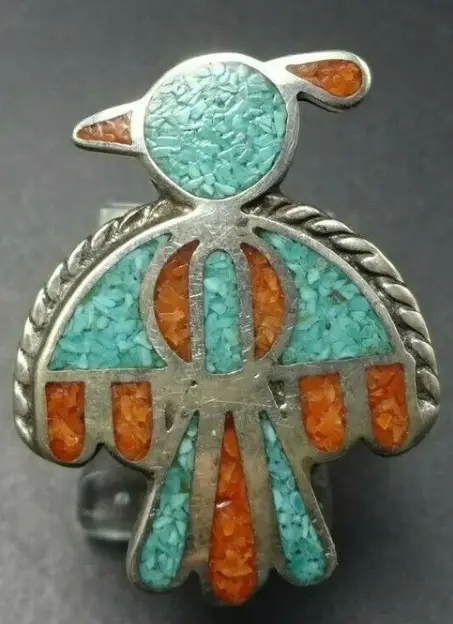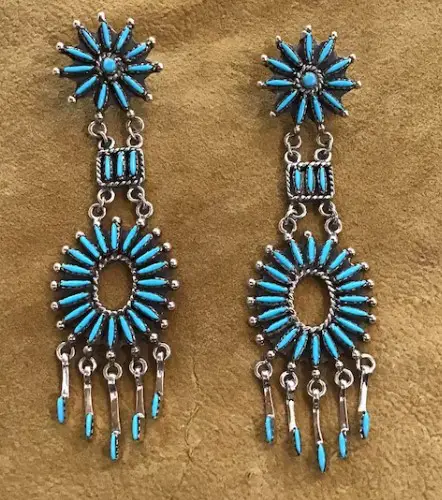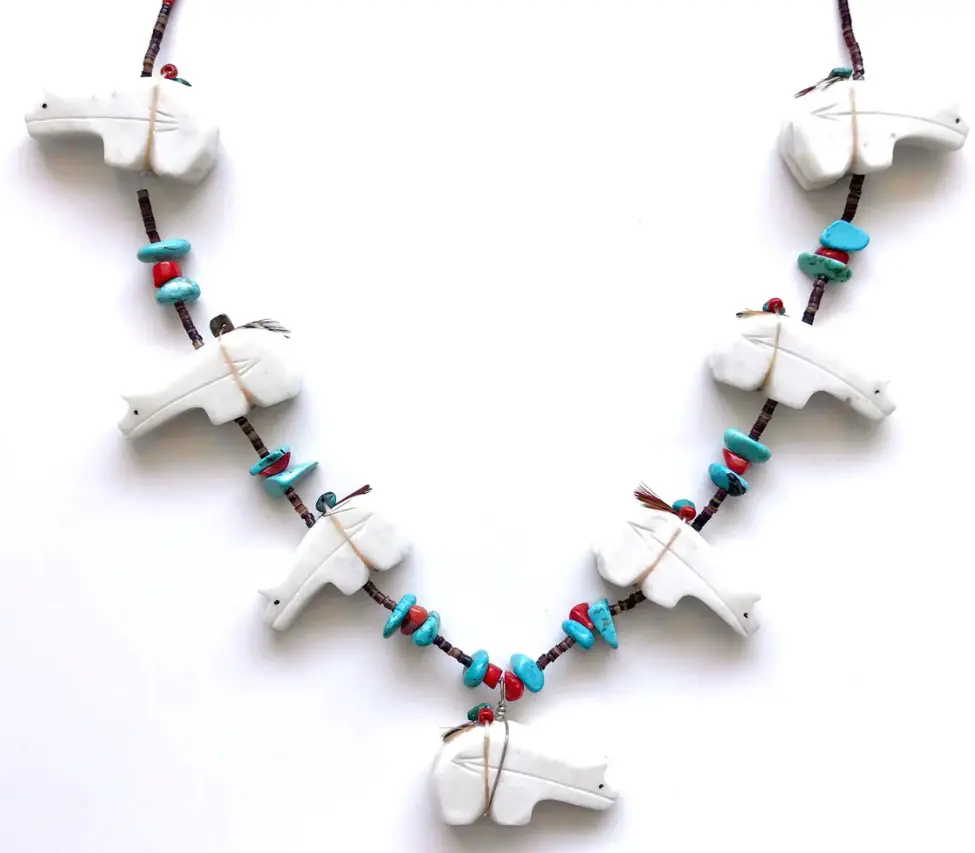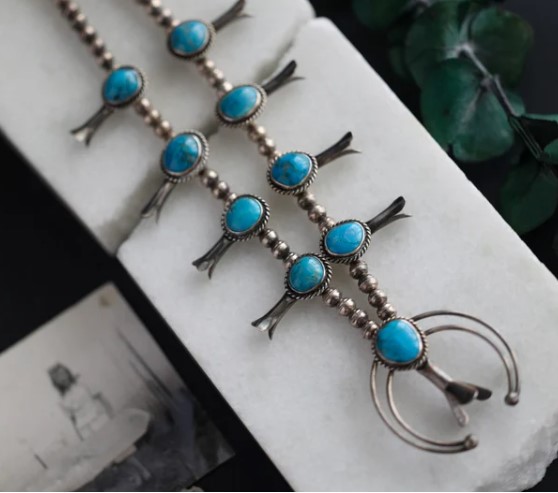Hey There! We may earn a commission from links on this page. This helps support the site and is at no extra cost to you. Thanks!
Native American turquoise jewelry is highly collectible. You will find finely crafted traditional jewelry made by Native American people including the Navajo, Pueblo, Hopi, Santo Domingo, Tewa, Acoma, and Zuni. Turquoise in blue and green has been important to these cultures for many years for crafting jewelry, most frequently made with silver.
Turquoise is often combined with shells, coral, semi-precious, and even precious stones. Navaho jewelry has garnered an international reputation for beautiful custom turquoise and silver jewelry of the southwest. Santo Domingo jewelry focuses on the mosaic inlay and heishi necklaces. Zuni work features excellent examples of needlepoint, petit point, and cluster turquoise design, as well as unique inlay works.
When collecting antique and vintage Native American turquoise jewelry, it is important to know the difference between Native American jewelry and jewelry produced in the southwestern style, but not necessarily authentically tribal.
What is Turquoise?
Turquoise is created within the earth’s crust due to a combination of copper and aluminum. Rich deposits of the stone are found in dry landscapes such as Egypt, Iran, Chile, Mexico, and parts of the United States including Arizona and New Mexico.
Native Americans refer to turquoise as Skystone for its distinctive blue color.
World History of Turquoise
Turquoise beads have been uncovered by archeologists in Egypt, dating back to 4500 BC. Beyond beauty, turquoise can be easy to cut, which would explain its early appeal in jewelry making.
Mines supplied many cultures with beautiful stones to create art and jewelry. Think Egyptians, Persians, and Tibetans. Closer to home turquoise was used by the Inca, Mesoamericans, and Native Americans. Turquoise also provided trade and commerce for the people.
The word for turquoise is derived from the French word meaning Turkish. Europeans were initially introduced to the gemstone through Turkey. The stone originated in Khorasan, Persia.
The History of Turquoise in North America
History illustrates that turquoise was first mined in 200 BCE. Ancient tribes mined turquoise in what is today New Mexico and Arizona. Archeologists have uncovered turquoise beads from these sites which were once home to Hohokam and Anasazi tribes.
Early Native American Works
Turquoise beading, stone cutting, and inlay work were all part of early Native American jewelry making. This was all creative before silversmith work was incorporated.
History of Silver
When Columbus reached Latin America and South America, indigenous people were already mining silver to produce decorative objects and adornments. Between the 16th and 18th centuries Bolivia, Peru, and Mexico produced 85 percent of the world’s silver.
The Art of Silver Smithing
Silver was highly prized, particularly in the 1800s when fine examples of buttons and pins were entering North America through trade with Mexico and Spain. The Spanish are credited with introducing Native Americans of the southwest to the art of silversmithing.
Atsidi Sani was the first Navajo silversmith, who began his work in the 1850s. After he mastered his skills, he taught his four sons the art.
The Zuni were intrigued by the Navaho works. Soon they took lessons on the craft from the Navaho, in exchange for livestock. By the 1890s, the Zuni taught Hopi people through the same bartering system.
What is Sterling Silver?
Sterling silver is silver that has been mixed with another alloy to make it stronger. One hundred percent sterling is too soft to craft with. Other materials that are added include copper or zinc. To be considered sterling silver in North America it must contain 92.5 percent silver.
Lapidary in Native American Turquoise Jewelry
The art of lapidary, or cutting stones is part of the Native American tradition in jewelry making. This knowledge has been passed down through the generations. By the mid-1800 Native Americans learned additional lapidary skills from the Spanish.
Stone Designs in Native American Turquoise Jewelry
- Single stone
- Multi-stone
- Row
- Multi-row
- Cluster
- Arranged cluster
- Random cluster
- Rainbow
A single stone design is anchored by one stone in the center. Multi-stone designs contain three to five stones worked together into a piece of jewelry. Row designs feature stones lined up in a row, which is usually horizontally. Multi-row designs feature an expansion of the basic row design.
A cluster has multiple stones, of one type or a variety, placed together in a group. Arranged clusters take on a traditional design such as the sunburst. This pattern has smaller stones radiating out from a large center stone. Random clusters may look unplanned but take precision in cutting stones of various sizes so that they all fit together.
Lapidary Techniques
When searching the marketplace for authentic Native American turquoise jewelry, there are many techniques to look for.
- Inlay
- Petit point
- Needlepoint
Native American Inlay Jewelry
Some of the most in-demand pieces include Native American inlay jewelry. Here stones are cut and shaped together to form intricate patterns and designs, with a smooth flat finish. These intricate works are highly individualistic.
Channel inlay involves first crafting the metal into channels to hold stones in place. Then, the stones are measured and cut to fit inside. This is the most classic style of Native American inlay jewelry.
Stone on stone inlay involves the cutting and shaping of stones so that each fits together side by side. It is set on metal with strong epoxy glue. Mosaic inlay has a similar method as stone on stone inlay, except it uses an outline of silver to secure the stone pattern in place.
Chip inlay was designed by artist Tommy Singer, in 1970. In this method, a piece of silver jewelry is designed with cut-in cavities. Next, stones are crushed. An epoxy resin is set inside the cavities, and the stones are placed inside to create visual effects.

Vintage Silver Turquoise Coral Chip Inlay Ring from TurquoiseKachina on Etsy
Petit Point and Needlepoint
Zuni people used the petit point and needlepoint techniques starting in the 1920s. Petit point features tiny cut stones in a variety of shapes such as circular, oval, square, rectangular, pear, and teardrop. These pieces are then used to create pendants, necklaces, bracelets, rings, and earrings.
Needlepoint is similar in that it uses small stones as well. How needlepoint differs from petit point is that each small stone is cut into a needle shape.

Vintage Zuni Petit Point Style Turquoise Earrings from HeyBelleBoutique on Etsy
Heishi Necklaces
Heishi means shell and once only referred to shell jewelry made by drilling holes in shells and stringing. Today the word also includes any tiny bead made into jewelry.
Heishi necklaces are made with patience and care by skilled craftspeople. Each bead almost perfectly resembles the one next to it. Heishi necklaces are thought to be the very first type of necklaces created by Native Americans.

Vintage Navajo Heishi Necklace from NativeJewelryStore on Etsy
Fetish Necklaces
Zuni people have always been highly skilled at carving animals out of stone to create fetish necklaces. These were used for both ceremonial and religious purposes. Each animal represents something different. Directions are symbolized by a mountain lion for the north, a wild cat for the south, a bear or coyote for the west, and east as a wolf.

Vintage Zuni Fetish Bear Animal Totem Necklace from ChicVintageHawaii on Etsy
Squash Blossom Necklaces
Squash blossom necklaces feature a combination of turquoise and silver. Silver beads and blossoms, made with stones and silverwork make up the necklace, with an inverted horseshoe pendant.
While the Navajo were the first to incorporate this squash blossom pattern into necklaces, the Zuni and Pueblo people were quick to follow.

Vintage Navajo Turquoise Squash Blossom Necklace from TradeWindVintage on Etsy
How to Identify Authentic Native American Turquoise Jewelry
When you are searching keep in mind that the price, materials used, hallmarks, and wording of the sellers, are all indications of authenticity.
Price
Every piece of Native American turquoise jewelry is handmade. This requires hours of work, and no two pieces will look exactly alike. Expect to pay for the artist’s time and skill. If the price is too low, you are probably purchasing a piece of jewelry that is not authentic.
Materials Used
Native American artists take pride in their work and use the finest materials. Look for natural turquoise stones, not stabilized. It is the law that dealers disclose whether turquoise is natural or has been stabilized.
For a quick silver test bring a magnet with you. Real silver will not hold a magnet. Other metals will. This is a sign of silver plating and is not an authentic piece of Native American jewelry.
Hallmarks
Many Native American jewelry artists add a stamp or a hallmark. Verify their hallmark by looking at other hallmarks on the artist’s work to establish it is authentic. It is important to note that not all artists stamp their work, so it doesn’t mean the pieces you would like to purchase are not authentic.
To indicate sterling jewelry, look for hallmarks with numbers and/or words such as the “.925” symbol and “sterling” or “sterling silver”.
The Indian Arts and Crafts Act
In 1990, the Indian Arts and Crafts Act was put in place to ensure that federally recognized nations or tribes could call their work Native American or Indian. Some stores may trick the buyer with words such as American Indian-inspired or American Indian-style. This is a sign that the jewelry you are looking at is not authentic.

